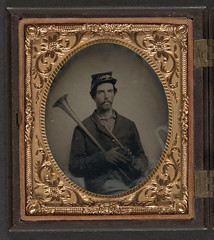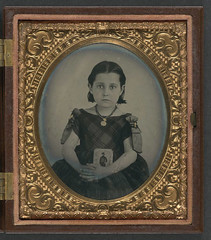Ambrotype

|

|

|
| Abraham Lincoln, Union soldier, girl with image of her father, images: Library of Congress (Image rights) | ||
Ambrotype is a photographic process resulting in positives on glass, originated by Frederick Scott Archer and Peter W Fry in 1851[1]. It was intended as a cheaper alternative to the Daguerreotype. It is based on the wet-collodion process. It was also known, in Britain, as "collodion positive".
Glass plates are prepared, and developed as in the wet-collodion process, but underexposed. This gives a less dark glass negative. The negative is treated with mercuric bichloride to whiten the exposed areas. The plate is mounted in a metal frame with a black background. The background makes the negative appear positive - as the whitened silvered areas reflect light, and the transparent areas show the black background.
The back was sometimes varnished or coated with balsam to improve the image; James Ambrose Cutting of Boston was granted a US patent in 1854[2] on a method of doing this - which makes the image "greatly increased in strength and beauty by imparting additional brilliancy", while also protecting the silver image with a glass backing.
Ambrotypes were often hand-tinted to increase the contrast; without this, Ambrotypes are grayish-white and compare poorly to Daguerreotypes.
Notes
- ↑ Focal Encyclopedia of Photography, Focal Press, 1976 edition, p.40
- ↑ US Patent 11,267 of 1854, Improvement in Photographic Pictures on Glass, granted to James A. Cutting; at Espacenet.
Links
- Wikipedia: Ambrotype - apparently wrongly attributes the invention to Cutting, whose patent USRE384E only mentions the varnish or balsam back coating.